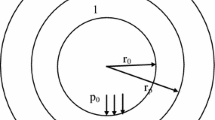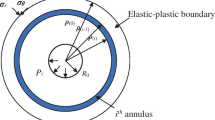Abstract
Based on the DP (Drucker–Prager) yield criterion, a new semi-analytical method for hydraulic–mechanical coupling in circular tunnels is proposed which takes into account the evolution of the permeability coefficient by incorporating it into the seepage equation. The definite condition is supplemented through the method of equal flow at the elastic–plastic junction. Constitutive equation and yield criterion are expressed by effective stress. When the pore water pressure drops to zero, the solution presented in this paper can degenerate into the classical Lamé solution in elastic region, and the solution obtained after yielding is consistent with the Drucker–Prage’s solution. The numerical simulation method is used to verify the proposed solution, and then, the sensitivity of the strength parameters is discussed. The results show that the radius of the plastic zone decreases with increasing cohesion C and internal friction angle φ°, and the decreasing tendency is more sensitive at lower cohesion and internal friction angle. Higher initial yield stresses are easily obtained by increasing the values of these two parameters appropriately. The solution presented in this paper is not applicable when the internal friction angle is greater than 40°. Considering the intermediate principal stress, the solution presented in this paper shows a higher initial yield in-situ stress than that of MC (Mohr–Coulomb) and Hoek–Brown (HB) materials. Compared with the solution of DP criterion, the solution in the current work has a larger range of plastic region, and is more obvious in high in-situ stress area. In addition, the initial yield stress also increases linearly with the head loss.
Highlights
-
A new closed semi-analytical solution of hydraulic–mechanical coupling in circular tunnel is proposed using equivalent permeability coefficient.
-
The hydraulic–mechanical coupling equation takes into account the action of intermediate principal stresses.
-
The solution proposed in this paper can degenerate into the classical Lamé solution when pore water pressure is equal to zero.












Similar content being viewed by others
Data availability
The data that support the findings of this study are available on request from the corresponding author Chaolin Wang (chaolinwang@126.com), upon reasonable request.
Abbreviations
- \(\sigma\) :
-
Stress
- \(\varepsilon\) :
-
Strain
- \(\varepsilon_{v}\) :
-
Volumetric strain
- \(\lambda\) :
-
Lamé constant
- G :
-
Shear modulus
- u :
-
Displacement
- r :
-
Radius
- Q :
-
Biot physical constant
- \(\rho\) :
-
Density of water
- k :
-
Permeability coefficient
- K 0 :
-
Initial permeability
- a :
-
Empirical constant
- A 1, A 2 :
-
Parameters of seepage equation
- C i :
-
Integration constant, i = 1, 2, 3, 4
- \(I_{1}\) :
-
Stress first invariant
- \(J_{2}\) :
-
The stress deviant is the second invariant
- \(\beta ,K\) :
-
The first and second strength parameters of DP rock mass
- \(\alpha\) :
-
Biot coefficient
- P:
-
Pore water pressure
- C :
-
Cohesion
- \(\varphi\) :
-
Internal friction angle
- n :
-
Pore volume
- n 0 :
-
Initial pore volume
- \(\vartheta\) :
-
Pore outflow water
- 0, y, R :
-
Effective stress variable value at r = tunnel periphery, elastoplastic interface, and outer boundary
- (e), (p):
-
Elastic region function/variable, plastic zone function/variable
- \(r,\theta ,z\) :
-
Direction of radial, tangential, and axial
References
Biot MA (1941) General theory of three-dimensional consolidation. J Appl Phys 12:155–164
Bobet A (2010) Characteristic curves for deep circular tunnels in poroplastic rock. Rock Mech Rock Eng 43:185–200. https://doi.org/10.1007/s00603-009-0063-z
Chen Y, Zhou C, Sheng Y (2007) Formulation of strain-dependent hydraulic conductivity for a fractured rock mass. Int J Rock Mech Min Sci 44:981–996. https://doi.org/10.1016/j.ijrmms.2006.12.004
De Caro M, Crosta GB, Previati A (2020) Modelling the interference of underground structures with groundwater flow and remedial solutions in Milan. Eng Geol 272:105652. https://doi.org/10.1016/j.enggeo.2020.105652
Detournay E, Cheng AHD (1988) Poroelastic response of a borehole in a non-hydrostatic stress field. Int J Rock Mech Min Sci Geomech Abstr 25(3):171–182. https://doi.org/10.1016/0148-9062(88)92299-1
Dong X, Karrech A, Qi C, Elchalakani M, Basarir H (2019) Analytical solution for stress distribution around deep lined pressure tunnels under the water table. Int J Rock Mech Min Sci 123:104124. https://doi.org/10.1016/j.ijrmms.2019.104124
Fahimifar A, Zareifard MR (2009) A theoretical solution for analysis of tunnels below groundwater considering the hydraulic–mechanical coupling. Tunn Undergr Space Technol 24:634–646
Fahimifar A, Zareifard MR (2013) A new closed-form solution for analysis of unlined pressure tunnels under seepage forces: analysis of pressure tunnels. Int J Numer Anal Methods Geomech 37:1591–1613. https://doi.org/10.1002/nag.2101
Fransson A, Viola G (2021) Bentonite rock interaction experiment: a hydro-structural-mechanical approach. Eng Geol 281:105985. https://doi.org/10.1016/j.enggeo.2020.105985
Kabwe E, Karakus M, Chanda EK (2020) Proposed solution for the ground reaction of non-circular tunnels in an elastic-perfectly plastic rock mass. Comput Geotech 119:103354. https://doi.org/10.1016/j.compgeo.2019.103354
Kolymbas D, Wagner P (2007) Groundwater ingress to tunnels—the exact analytical solution. Tunn Undergr Space Technol 22:23–27
Lee SW, Jung JW, Nam SW, Lee IM (2007) The influence of seepage forces on ground reaction curve of circular opening. Tunn Undergr Space Technol 22:28–38. https://doi.org/10.1016/j.tust.2006.03.004
Li B, Zhang H, Luo Y, Liu L, Li T (2022a) Mine inflow prediction model based on unbiased Grey–Markov theory and its application. Earth Sci Inf 15:1–8. https://doi.org/10.1007/s12145-022-00770-2
Li B, Zhang W, Long J, Fan J, Chen M, Li T, Liu P (2022b) Multi-source information fusion technology for risk assessment of water inrush from coal floor karst aquifer. Geomat Nat Haz Risk 13:2086–2106. https://doi.org/10.1080/19475705.2022.2108728
Sharan SK (2005) Exact and approximate solutions for displacements around circular openings in elastic–brittle–plastic Hoek–Brown rock. Int J Rock Mech Min Sci 42:542–549
Shin YJ, Kim BM, Shin JH, Lee IM (2010) The ground reaction curve of underwater tunnels considering seepage forces. Tunn Undergr Space Technol 25:315–324. https://doi.org/10.1016/j.tust.2010.01.005
Shin JH, Lee IM, Shin YJ (2011) Elasto-plastic seepage-induced stresses due to tunneling. Int J Numer Anal Meth Geomech 35(13):1432–1450. https://doi.org/10.1002/nag.964
Wang Y, Dusseault MB (1994) Stresses around a circular opening in an elastoplastic porous medium subjected to repeated hydraulic loading. Int J Rock Mech Min Sci Geomech Abstr 31:597–616. https://doi.org/10.1016/0148-9062(94)90003-5
Wang S, Elsworth D, Liu J (2013) Permeability evolution during progressive deformation of intact coal and implications for instability in underground coal seams. Int J Rock Mech Min Sci 58:34–45. https://doi.org/10.1016/j.ijrmms.2012.09.005
Wang CL, Zhang KP (2022a) An adsorption model for cylindrical pore and its method to calculate pore size distribution of coal by combining NMR. Chemical Engineering Journal 450:138415- https://doi.org/10.1016/j.cej.2022.138415
Wang CL, Zhao Y, Ning L, Bi J (2022b) Permeability evolution of coal subjected to triaxial compression based on in-situ nuclear magnetic resonance. Int J Rock Mech Min Sci 159:105213
Xu Z, Xu X, Lu B (2000) An analytical solution for elastoplastically nonlinear seepage coupling. J Chongqing Univ (Nat Sci Ed) s1:184–187 (in Chinese)
Xu P, Yang SQ (2016) Permeability evolution of sandstone under short-term and long-term triaxial compression. Int J Rock Mech Min Sci 85:152–164. https://doi.org/10.1016/j.ijrmms.2016.03.016
Yang SQ, Huang YH, Jiao YY, Zeng W, Yu QL (2015) An experimental study on seepage behavior of sandstone material with different gas pressures. Acta Mech Sin 31:837–844. https://doi.org/10.1007/s10409-015-0432-7
Zareifard MR, Fahimifar A (2014) Effect of seepage forces on circular openings excavated in Hoek–Brown rock mass based on a generalised effective stress principle. Eur J Environ Civ Eng 18:584–600
Zhang B, Chen F, Wang Q (2019) Elastoplastic solutions for surrounding rock masses of deep-buried circular tunnels with non-darcian flow. Int J Geomech 19:04019065
Zhao CX, Zhang ZX, Lei QH (2021) Role of hydro-mechanical coupling in excavation-induced damage propagation, fracture deformation and microseismicity evolution in naturally fractured rocks. Eng Geol 289:106169
Zhao Y, Zhang YF, Tian G, Wang CL, Bi J (2022) A new model for predicting hydraulic fracture penetration or termination at an orthogonal interface between dissimilar formations. Petroleum Science 19(6): 2810-2829. https://doi.org/10.1016/j.petsci.2022.08.002
Zhang YF, Long AF (2023) Mutual impact of true triaxial stress borehole orientation and bedding inclination on laboratory hydraulic fracturing of Lushan shale. Journal of Rock Mechanics and Geotechnical Engineering https://doi.org/10.1016/j.jrmge.2023.02.015
Acknowledgements
This research was supported by National Natural Science Foundation of China (Nos. 52264006, 52004072, 52064006, and 52164001), the Guizhou Provincial Science and Technology Foundation (Nos. [2020]4Y044, [2021]292, [2021]N404, and GCC[2022]005-1), Youth Science and technology Talents Development Project of Guizhou Ordinary Colleges and Universities (No. [2022]140), and Specialized Research Funds of Guizhou University (Grant Nos. 201903, 202011).
Author information
Authors and Affiliations
Corresponding author
Ethics declarations
Conflict of Interest
The authors declared that they have no conflicts of interest to this work. We declare that we do not have any commercial or associative interest that represents a conflict of interest in connection with the work submitted.
Additional information
Publisher's Note
Springer Nature remains neutral with regard to jurisdictional claims in published maps and institutional affiliations.
Rights and permissions
Springer Nature or its licensor (e.g. a society or other partner) holds exclusive rights to this article under a publishing agreement with the author(s) or other rightsholder(s); author self-archiving of the accepted manuscript version of this article is solely governed by the terms of such publishing agreement and applicable law.
About this article
Cite this article
Zhao, Y., Wei, T., Wang, C. et al. A New Close-Form Solution for Elastoplastic Seepage-Induced Stresses to Circular Tunnel with Considering Intermediate Principal Stress. Rock Mech Rock Eng 56, 6545–6557 (2023). https://doi.org/10.1007/s00603-023-03399-9
Received:
Accepted:
Published:
Issue Date:
DOI: https://doi.org/10.1007/s00603-023-03399-9




